Like heavy storms in other parts of the country, monsoons in the desert Southwest often leave a path of destruction, including flooding, fallen branches, uprooted trees or all of the above, in their wake.
Whether you live in the Southwest or another region that experiences heavy rainfall and high winds, there are steps you can take to avoid or minimize the damage these events can cause to your landscape. Let’s take a look at the different types of landscape damage that can occur as a result of these severe weather events and ways you can help prevent or lessen much of the damage they can cause.
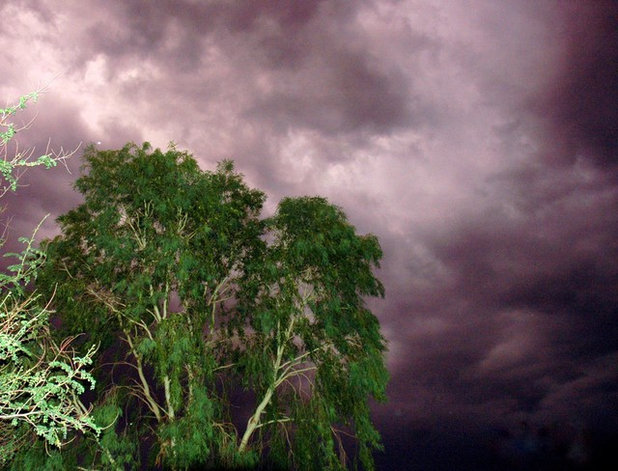
Noelle Johnson Landscape Consulting
What is a monsoon? The word
monsoon comes from the Arabic word
mausim,
which means
season or
wind shift. Monsoons affect many parts of the world. In the United States, the southwestern region, including Arizona, New Mexico, western Texas, southern Utah, Colorado and southern Nevada, experiences this seasonal phenomenon.
Winds and storms typically blow into this region from the west, but in June the wind shifts to come from the south, bringing in the more humid air from the Pacific Ocean and the Gulf of Mexico. This moist, humid air is what triggers monsoons. The humid airflow leads to the occurence of thunderstorms, which trigger severe weather events such as high winds, dust storms, lightning, torrential rainfall and flooding. This wind shift generally lasts from late June through the end of September.
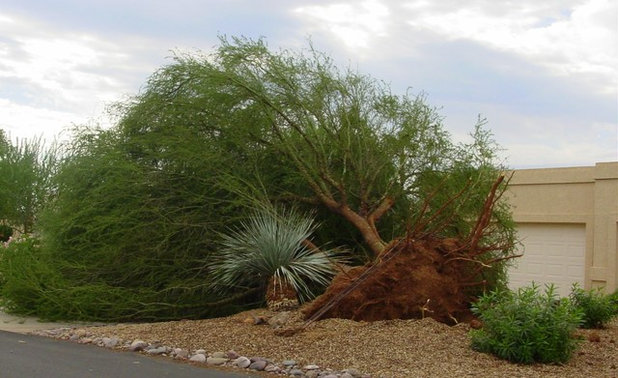
Noelle Johnson Landscape Consulting
Wind DamageWhile you cannot completely prevent damage from high winds, you can decrease the incidence and severity of damage to your trees by pruning correctly, watering deeply and choosing a suitable tree species.
High winds during a storm can uproot trees, and they often leave behind a path of broken branches in their wake. Two major factors increase the likelihood that your trees will incur damage from the high winds: shallow root growth and overhanging branches due to overgrowth or incorrect pruning.
Trees are often watered too shallowly or rely on the water recieved from surrounding plants. Unlike perennials and shrubs, trees should be watered to a depth of 3 feet, which encourages deep root growth that helps them withstand strong winds, decreasing the chance of their being uprooted. Even mature trees that survive on natural rainfall do best when watered deeply once a month in summer.
Shown: An uprooted palo verde tree
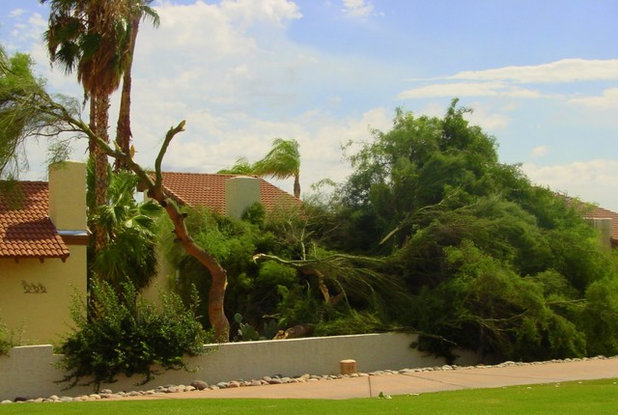
Noelle Johnson Landscape Consulting
Another major type of monsoon damage happens to trees that are overgrown, have been improperly pruned or both. Long, overhanging branches with a lot of weight on the ends are prime candidates for suffering damage from windy conditions.
The angle at which a branch is attached to a tree can also indicate the likelihood of whether or not it can handle high winds. In general, the narrower the angle where a branch is attached, the more susceptible the branch is to breaking. Wider angles mean a stronger branch attachment.
Shown: An overgrown tree that suffered severe damage from the high winds during a monsoon
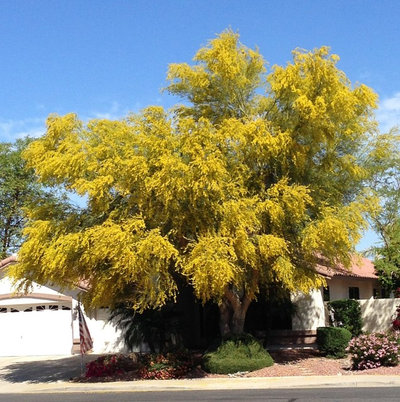
Noelle Johnson Landscape Consulting
Inspect your trees annually, ideally in late spring before the rainy season, to reduce the chance they will suffer significant wind damage. Prune back any long, heavy, overhanging branches so that the tree and its trunk can better support the branches. (It’s important when pruning to prune back to another branch.)
Hire a certified arborist if you’re in doubt as to whether your tree is at risk of substantial wind damage.
Shown: A large palo verde tree with overgrown branches, making it susceptible to severe wind damage.
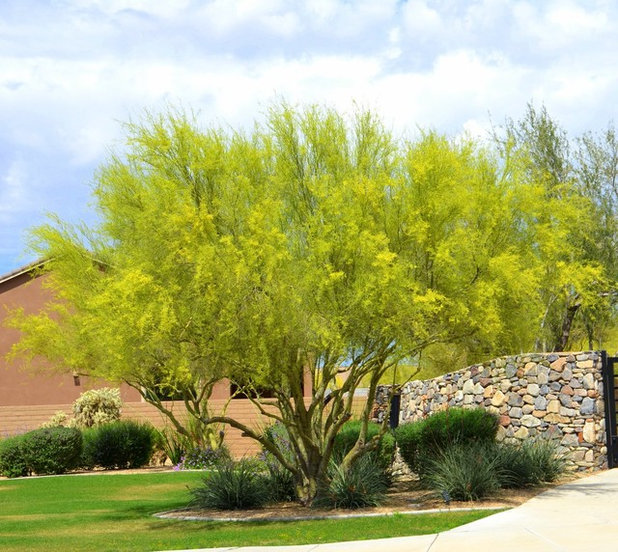
Noelle Johnson Landscape Consulting
The type of tree you plant can also contribute to the risk of wind damage. Multitrunk trees are less prone to broken branches, because the weight of the branches is shared among three to five trunks instead of a single one. Some trees are more susceptible to wind damage, including eucalyptus, mesquite (
Prosopis spp.) and willow acacia (
Acacia salicina). Contact a nursery professional or certified arborist for a list of trees susceptible to wind damage, and avoid them.
It is a wise precaution to keep parked cars and other important items away from trees when monsoons are forecast.
Shown: A multitrunk foothills palo verde tree (
Parkinsonia microphylla), which is better able to withstand the high winds of monsoon season than a single-trunk (standard) tree.

Noelle Johnson Landscape Consulting
Dust StormsTowering walls of dust sometimes precede approaching thunderstorms in the desert Southwest. Commonly referred to as haboobs, these giant dust storms can top 3,000 feet. Once they hit, they severely impair visibility to just a couple of feet, making it dangerous to be outdoors. Thunderstorms often follow dust storms.
Shown: A large dust storm approaching
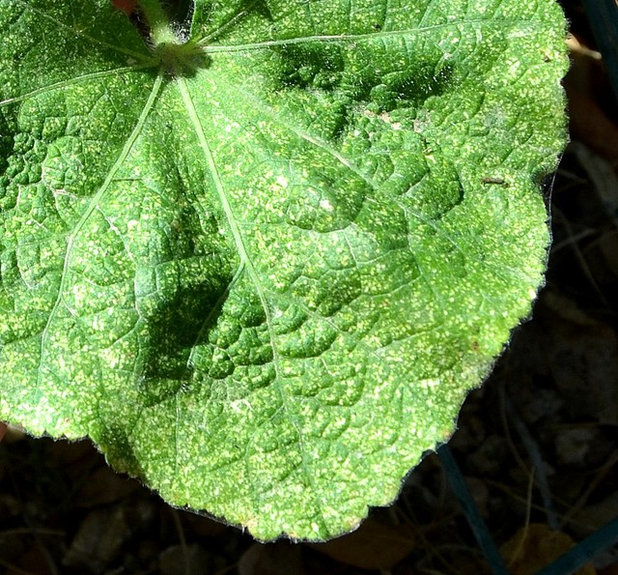
Noelle Johnson Landscape Consulting
Dust storms can also create a welcome environment for spider mites, tiny mites about the size of a grain of sand that congregate on the undersides of leaves and suck the sap from plants. The dusty conditions that result from dust storms protect them and their eggs from insect predators.
Spider mites cause tiny yellow specks on the leaves. Advanced infestations of spider mites will often cause visible webbing on the leaves and a scorched appearance. Plants can die from severe spider mite infestations.
Infestations of spider mites can best be treated with insecticidal soap when they’re first observed. The easiest way to prevent problems with spider mites that thrive in hot, dry conditions is to lightly spray plants with water every few days in the absence of rain.
Shown: A hollyhock leaf showing the initial speckling caused by spider mites
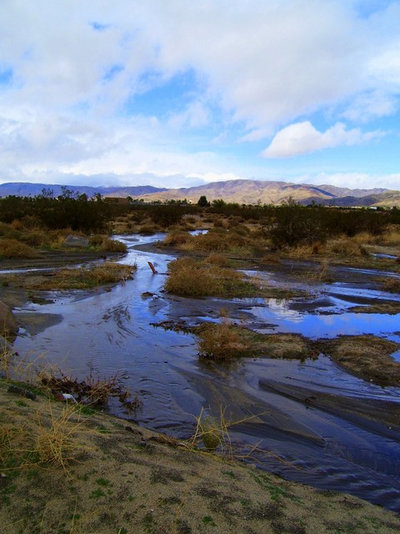
Noelle Johnson Landscape Consulting
FloodingThunderstorms bring torrential amounts of rain in a very short period of time, and all that water needs someplace to go. Natural channels, called arroyos or washes, exist throughout the Southwest landscape and take care of directing much of the rain that falls. But in our towns and cities, most of the natural washes have been paved over, which means that the water has to be channeled elsewhere to prevent flooding.
Shown: A desert wash after a monsoon

Noelle Johnson Landscape Consulting
Large retention areas in parks and landscaped common areas capture large amounts of stormwater, which then slowly percolates through the soil over a period of several days.
In residential landscapes, there are several things you can do to minimize the risk of flooding. First and foremost, all hard surfaces, such as porches and patios, surrounding your home should be sloped outward at least 2 percent to direct water away from your home and reduce the risk of flooding. Instead of allowing water to flow into the street, channel it toward your plants with swales and mounds. Not only will this save you money on your water bill, but it will also flush away accumulated salts in the soil.
Shown: Rainwater from a front entry being directed toward a young tree
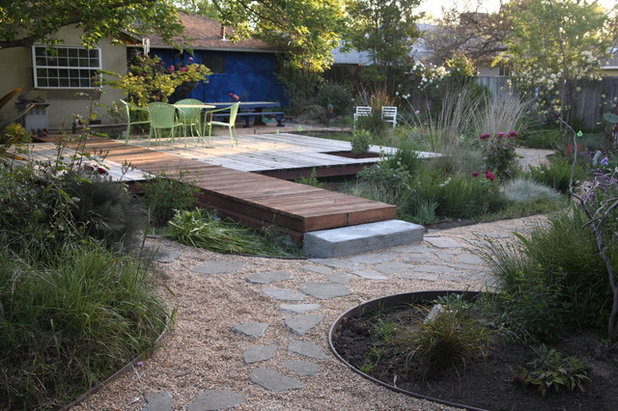
Luciole Design Inc.
Minimize the use of impermeable surfaces like asphalt, brick and concrete, or mix them with permeable surfaces like gravel or permeable pavers. Paths can be created using decomposed granite alone or using concrete, flagstone or paver steppingstones. These porous surfaces let water be absorbed into the ground, reducing the risk of flood and preventing stormwater runoff.
Discover how to manage stormwater in your landscape
Shown: A landscape maximized to absorb rainfall with rain gardens along gravel paths, interspersed with pavers
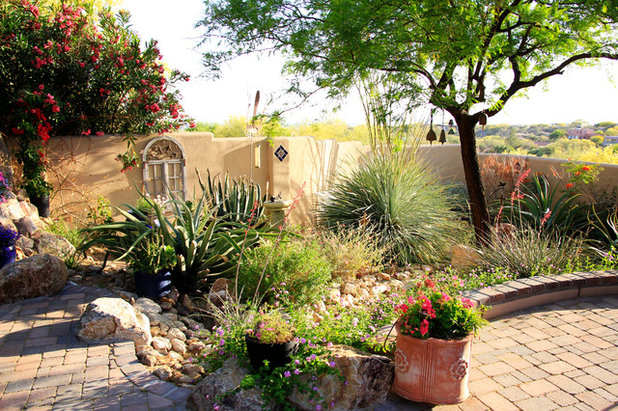
Santa Rita Landscaping, Inc.
Rain gardens reduce the risk of flooding and can be used to harvest rainwater. Water is channeled away from the house toward the rain garden, a low, planted area in the landscape, to percolate back into the landscape.
Read more about rain gardens
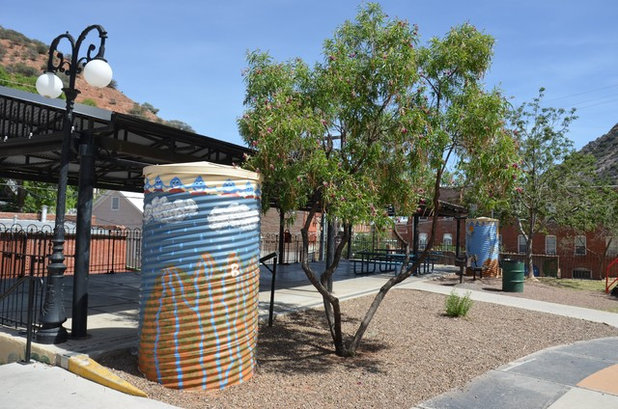
Noelle Johnson Landscape Consulting
If allowed where you live, rain barrels can be quite effective in watering your landscape and preventing landscape flooding. They collect water from the roof for later use and are easy to install.
Learn more about rain barrels and other ways to harvest rainwater for your garden
Shown: A pair of rain-harvesting cisterns at a park in Bisbee, Arizona

Harding Construction & Sustainable Solutions
A few more monsoon season landscape tips:- Clean out rain gutters and outdoor drains so that rainwater flows freely.
- Skip an irrigation cycle after a monsoon thunderstorm in which ¼ to ½ inch of rain falls; there’s no need to water your plants twice.
- Check to see if your irrigation controller has a battery backup. Monsoons can knock out power, and your water-reuse system will be lost if you don’t have a backup power source.
Shown: A drought-tolerant landscape with a rain-harvesting cistern and concrete pavers interplanted with ground covers that allow rainwater to permeate the ground.





